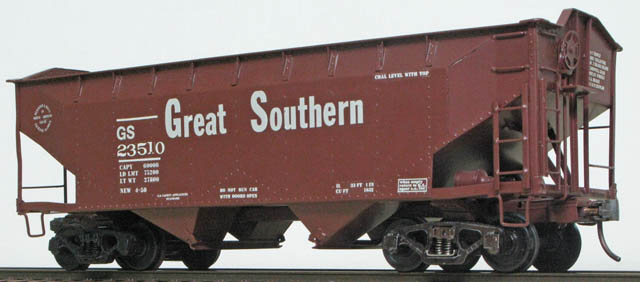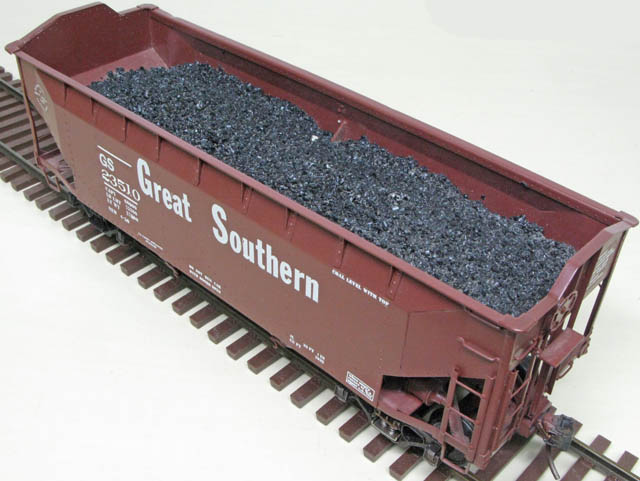I have a HO layout with many different types of cars. Is there a recommended weight for cars and does it differ for different types of cars? Thanks for your help.
The National Model Railroad Association recommendation for all HO cars is 1 ounce of weight, plus 1/2 ounce for each inch of the car’s length. So an HO car that’s 6" long should weigh 4 ounces - 1 oz base weight plus another 3 ounces (1/2 oz x 6").
https://www.nmra.org/sites/default/files/standards/sandrp/pdf/rp-20.1.pdf
NMRA publishes recommended standards. 1/2 oz per inch of car weight is approximately the amount.
Thanks for your speedy replies. This is exactly the information I was looking for.
The formula given is correct but I like my cars a little heavier than what the NMRA recommends. A number of years ago somebody suggested one ounce for every ten scale feet of car length. A 40 foot box car is 4 oz., a fifty footer is 5 oz., and so on. By comparison using NMRA standards, a 40 foot boxcar is 5 1/2 inches which would call for a weight of 3.75 oz. A 50 foot boxcar is 7 inches which would call for a weight of 4.5 oz. I’ve found the added weight is especially helpful on longer passenger cars. Besides the formula I use is easier to figure out for those of us who are arithmetically challenged.
The real problem is what to do with open top cars, especially empties. It’s hard to give them the correct weight no matter which standard you use and there’s not a good place to put added weights. I recently built a small fleet of hopper cars and I painted the weights black and put them down as low as I could so the weights wouldn’t be so conspicuous. Many tank cars are difficult to add weight to because not all of them are built so you can add weight inside the tank.
The weights of my rolling stock are, in many cases, all over the map. The worst for hiding weight are open hoppers - I can get 50 ton (2-bay) hoppers up to 8 ounces apiece when loaded (“live” loads), but many are only 2 oz. when empty, and easily popped off the track by run-in slack action within the train.
I kitbashed some Rivarossi heavyweight passenger cars and used custom cast lead weights to make them track more prototypically, with less rocking and shaking than occurred without the added weight.
However, the experiment didn’t take long before the cars’ weight, about 15oz. apiece, started to wear-away the inside cavities in the soft plastic of the Rivarossi journal boxes and/or the ends of the Kadee wheels’ axles, which caused to wheels to drop out if the car was lifted off the layout.
I’ll eventually replace those trucks with ones from Walthers, then re-install the weights, as they really do make the cars roll in a very prototypical manner.
Wayne
If you don’t weight your cars evenly make sure you run the lighter ones further back in the train. I would avoid weighting a caboose by much.
If you use pushers, as I often do, some extra weight in the caboose is a good idea.
Wayne
In the Rockies pushers were pullers, or less often, cut in behind the mainline locomotives. Possibly out of respect for the underframes of cabooses.
More than one pusher was usually added for Rogers Pass and the Big Hill at Field.
Well, I can’t speak for railroad crossing the Rockies in the US or Canada becuse I simply don’t know. But steam railroads crossing the Appalachian Mountains used pushers a lot.
And they upgraded caboose frames, and soon caboose bodies, to steel early on for that reason.
Cranberry Grade on the B&O is nearly 3% and nothing but curves. 100 car hopper trains typically required two 2-8-8-0’s on the point, and two more on the rear.
Diesels replaced the helpers long before the primary train power was diesel, so four unit F3’s or F7’s would push while two 2-8-8-0’s or two 2-8-8-4’s pulled.
The diesels were not only better pushers, but also did not have to be turned to work both directions.
Sheldon
I’m familiar with the practice in the Canadian Rockies. The biggest steam power in the country was built for pusher service until the Selkirk (Texas) came along and proved to be a versatile and powerful mainline locomotive.
Canadian practice still referred to the helper locomotives as pushers even though they weren’t.
The B&O used their 2-10-2 Santa Fe type, known as the “Big Sixes” since the whole class was numbered in the 6000’s, on their other route west thru Pittsburgh.
The curves on the MD/WV old mainline were too sharp for them - they tried one once…layed it over on its side!
That’s why smaller drivered articulated locos were so popular in the eastern mountains. The mountains here might not be as tall, but they are still pretty rugged in terms of finding rail routes thru them - again, nothing but curves, often pretty sharp ones.
There are in fact a sizeable number of east coast articulated locos that seldom or never have appeared in model form.
Remember, the single most prolific articulated wheel arrangement was the 2-6-6-2, and not all of them were the C&O/USRA design. Not to mention 2-8-8-0’s, and 4-6-6-4’s of completely different designs from those on the UP.
Apparently articulated locos never found any favor in Canada?
When it comes to weight in model rolling stock, I try to get my cars close to the NMRA Recommended Practice, and I prefer to do that frist by installing metal sprung/equalized trucks with all metal wheelsets to keep the weight as low as possible.
Most of my freight rolling stock has Kadee metal trucks refitted with Intermountain wheelsets. This adds weight down low, and is a very free rolling setup.
Sheldon
CPR built several 0-6-6-0 pushers specifically for Field Hill. Very steep grades. There have been many runaways, some quite recently. I think the ruling grade is still over 2% today. When it was built it was over 4% it seems to me. The Spiral Tunnels were built to bring the grade down closer to 2%.
These 0-6-6-0 were a bit different in that the engines faced each other. They worked well but CPR decided to convert a couple to big 2-10-0. Those worked better and all the 0-6-6-0 were so converted. The 2-10-0 series was expanded.
CPR used those plus Consolidations, Mikados and then Santa Fe’s for pusher service.
Sounds like a good excuse to use the prototype practice of putting the pusher in front of the caboose. It would require extra switching at both ends of the run. A nuisance for the prototype railroads but a plus for the modeler who likes switching.
My rule of thumb for weight is to keep them on the light side. Some of my steam locos are not the greatest pullers… If derailing happens, I try to address the issue without changing weights. I will add some weight as a last resort.
Simon
There are plenty of ways to hide the weights you add on a car. Many older cars seem lighter than newer ones. They benefit from the weight also to avoid de-railments.
Good tips about weighting our cars.
One somewhat humorous story that I can add to this discussion:
A modeler, that I painted passenger cars for, invited me to his home to check out his layout and run my trains on it. Nice sized layout that was nearly flat with no grades. As I ran my SCL passenger train, he ran a 30 car coal train, hauled by a triple headed-6 axle lashup. Well, my jaw dropped open when I saw…AND HEARD a rapid…"Grum!-Grum!-Grum!-Grum!-Grum!. His locomotives’ wheels were spinning severely and those rails were getting polished! He then confessed to me that each coal hopper weighed nearly 1 pound!
I gently cautioned him that he was putting a very hard strain on his Kato, Atlas, and Genesis units and reminded him that today’s locomotives cannot take the type of punishment that the 1970’s production Athearn BB units (that he had been accustomed to) could endure. He laughed about it and said he would “lighten their loads” which were cut pieces of flat steel underneath the plastic coal loads.
These photos are an O-scale model I bought 10 years ago. It weights 32-oz, more than double the 13.4-oz of NMRA RP 20.1. Was there no gradient in Lorell Joiner’s Great Southern R.R.?


What’s under this coal? Because he seems to have been a millionaire, is it a gold nugget? ![]()
Pushing cabooses up mountain grades just wasn’t the practice. The underframes of cabooses couldn’t take the loads.
A question looking for a survey of answers. Do most people remove loads from open hoppers, gondolas, and flat cars when they are supposed to be empties? Or for weight and potential damage to load issues do people leave the loads alone and just move the cars back and forth? I know this is one of those it is your railroad do what you want,but I was curious what most people do.